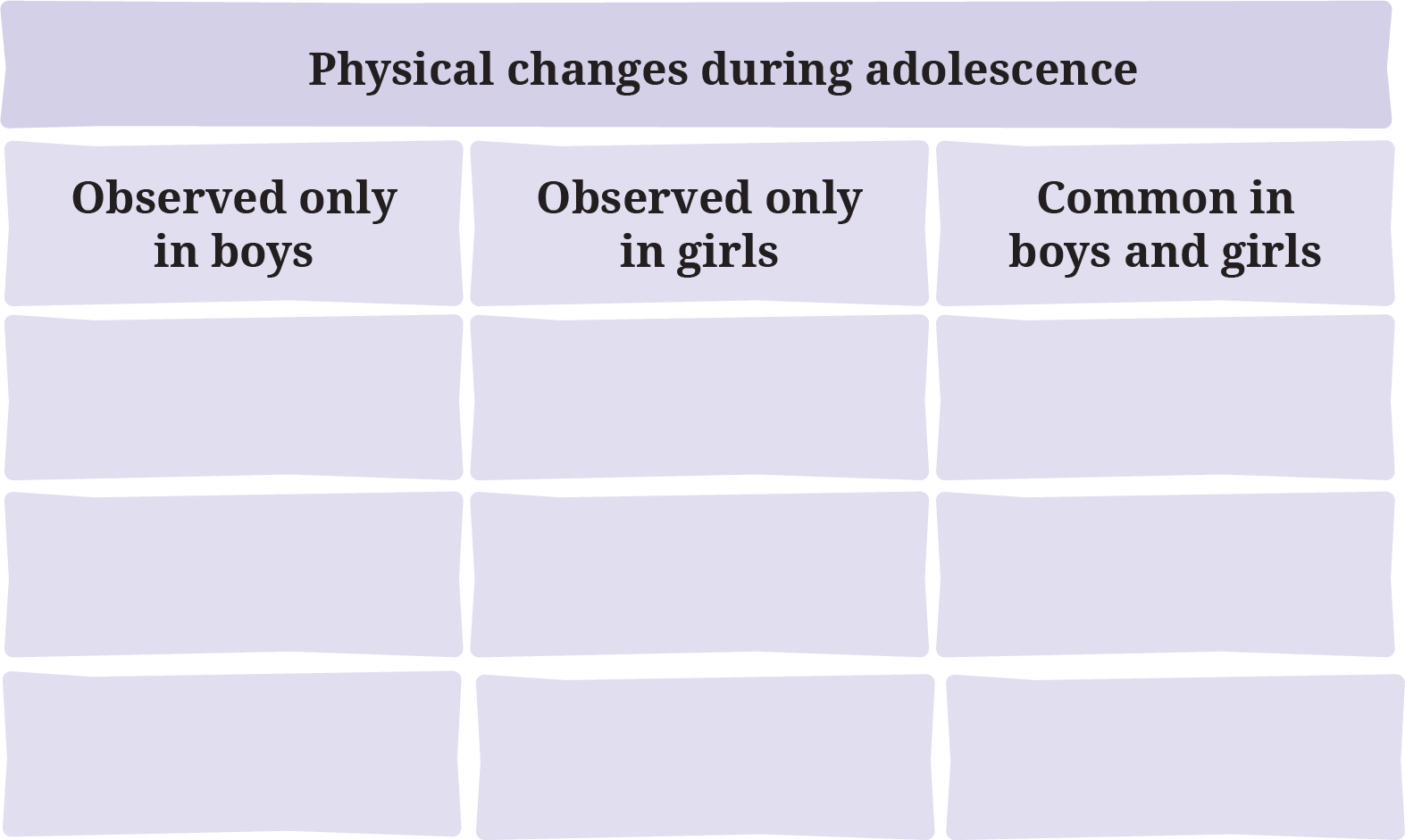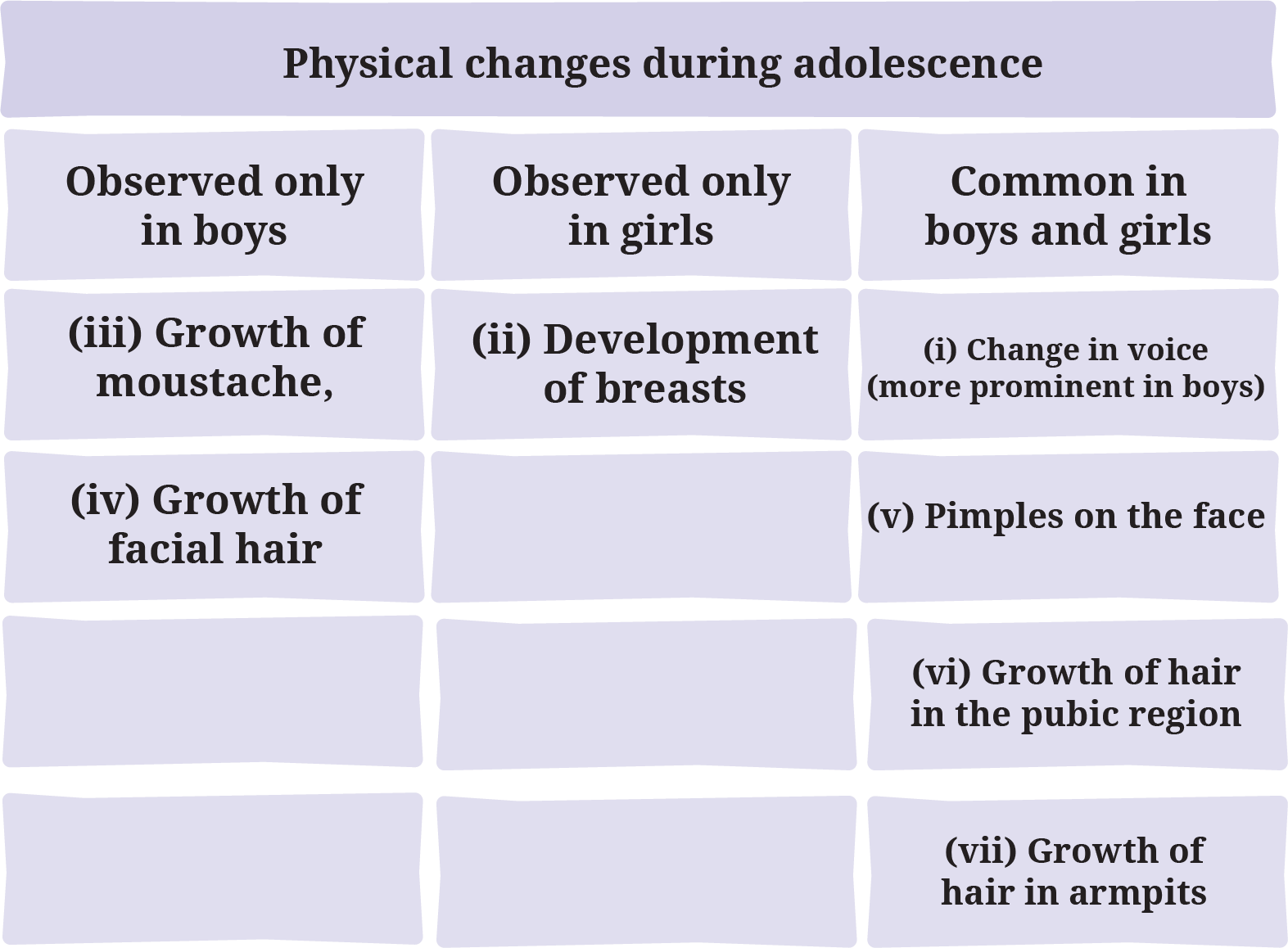NCERT Solutions for Class 7 Science Curiosity Chapter 6 Adolescence – A Stage of Growth and Change revised for Session 2025-26. It gives clear and accurate answers to all exercise and intext questions, helping students understand physical, emotional and hormonal changes during adolescence. NCERT Science Curiosity solutions highlight important topics like menstruation, hygiene, nutrition and responsible behavior. NCERT Class 7 Science Curiosity Chapter 6 Solution promotes scientific thinking and self-awareness, making it easier for students to cope with this transitional phase in a healthy and informed manner.
Class 7 Science Solutions
Class 7 Science Curiosity Chapter 6 Solutions
Let Us Enhance Our Learning
1. Ramesh, an 11-year-old boy, developed a few pimples on his face. His mother told him that this is because of ongoing biological changes in his body.
(i) What could be the possible reasons for the development of these pimples on his face?
(ii) What can he do to get some relief from these pimples?
See Answer(i) Possible Reasons: Pimples (acne) are common during adolescence. They occur due to increased activity of oil glands in the skin during adolescence, leading to oily secretions that can clog skin pores and sometimes lead to infections. This is a normal biological change associated with puberty.
(ii) Relief: Maintaining good personal hygiene is important. This includes washing the face regularly to remove excess oil and dirt. Avoid touching or squeezing pimples. Eating a balanced diet might also help. If acne is severe, consulting a doctor is advisable.
2. Which of the following food groups would be a better option for adolescents and why? (Assuming image (i) shows junk food and image (ii) shows a balanced meal)

See AnswerOption (ii) (the balanced meal) would be a better option.
Reason: Adolescence is a period of rapid growth and development requiring a balanced and nutritious diet. A balanced meal provides essential nutrients like proteins (for growth, strength), carbohydrates (for energy), fats, vitamins and minerals (like calcium for bones, iron for blood) needed during this stage. Junk food typically lacks these essential nutrients.
3. Unscramble the underlined word in the following sentences:
(i) The discharge of blood in adolescent girls which generally occurs every 28-30 days is nstmnoiaretu.
(ii) The hoarseness in the voice of adolescent boys is due to enlarged iceov xob.
(iii) Secondary sexual characteristics are natural signs that the body is preparing for adulthood and mark the onset of urtypeb.
(iv) We should say NO to lahoclo and srugd as they are addictive.
See Answer(i) nstmnoiaretu -> menstruation
(ii) iceov xob -> voice box
(iii) urtypeb -> puberty
(iv) lahoclo, srugd -> alcohol, drugs
4. Shalu told her friend, “Adolescence brings only physical changes, like growing taller or developing body hair.” Is she correct? What would you change in this description of adolescence?
See AnswerShalu is incorrect.
Changes to Description: Adolescence involves much more than just the physical changes Shalu mentioned. It’s a period that also includes significant internal biological changes leading to reproductive maturity (like the onset of menstruation in girls), as well as important emotional and behavioural changes, such as mood swings, increased sensitivity, self-exploration and changes in social interactions.
5. During a discussion in the class, some of the students raised the following points. What questions would you ask them to check the correctness of these points?
(i) Adolescents do not need to worry about behavioural changes.
(ii) If someone tries a harmful substance once, they can stop anytime they want.
See Answer(i) Question: The chapter mentions emotional and behavioural changes like mood swings and increased sensitivity are common during adolescence. Isn’t it important to understand these changes to navigate this period thoughtfully and make better choices?
(ii) Question: The text states that substances like alcohol and drugs are addictive, meaning they create a strong urge to use them repeatedly. Doesn’t this addictive nature make it very difficult for someone to stop easily, even after trying just once?
6. Adolescents sometimes experience mood swings. On some days, they feel very energetic and happy, while on other days, they may feel low. What other behavioural changes are associated with this age?
See AnswerBesides mood swings, other common behavioural changes associated with adolescence include: Increased sensitivity; Stronger emotions compared to childhood; Self-exploration and developing deeper interests; Increased interaction with peers, sometimes mimicking their behaviour; Heightened curiosity; Potentially engaging in creative activities or social initiatives.
7. While using a toilet, Mohini noticed that used sanitary pads were scattered near the bin. She got upset and shared her feelings with her friends. They discussed the importance of menstrual hygiene and healthy sanitary habits. What menstrual hygiene and sanitary habits would you suggest to your friends?
See AnswerSuggested habits include: Maintain overall personal body hygiene, especially during menstruation; Use clean sanitary products like sanitary pads or reusable cloth pads; Change pads regularly according to need; Dispose of used sanitary pads properly: wrap them (e.g., in newspaper) before placing them inside a dustbin. Do not flush them or leave them scattered; Advocate for clean and adequate toilet facilities in schools and public places; Help reduce stigma around menstruation and sanitary products.
8. Mary (11) developed a bulge on her neck and needed iodine-rich diet/medication. Manoj (12) developed a neck bump deemed normal. According to you, what could be the possible reason for advising Mary and Manoj differently?
See AnswerMary’s bulge, requiring medication and an iodine-rich diet, likely indicates a medical condition such as goitre, which can be caused by iodine deficiency affecting the thyroid gland. Manoj’s bump is likely the Adam’s apple, which is the normal and visible growth of the voice box (larynx) in boys during puberty. It’s a secondary sexual characteristic and part of normal development.
9. During adolescence, the boys and girls undergo certain physical changes, a few of which are given below. Categorise these changes in the table provided:
(i) Change in voice
(ii) Development of breasts
(iii) Growth of moustache
(iv) Growth of facial hair
(v) Pimples on the faces
(vi) Growth of hair in the pubic region
(vii) Growth of hair in armpits

See AnswerObserved only in boys:
(iii) Growth of moustache, (iv) Growth of facial hair
Observed only in girls:
(ii) Development of breasts
Common in boys and girls:
(i) Change in voice (more prominent in boys), (v) Pimples on the face, (vi) Growth of hair in the pubic region, (vii) Growth of hair in armpits

10. Prepare a poster mentioning the tips for adolescents to live a healthy lifestyle.
See AnswerTips for a poster on a healthy adolescent lifestyle could include: Eat Balanced Meals (Include fruits, vegetables, grains, proteins, dairy. Ensure adequate iron intake); Stay Active (Engage in regular physical activity, sports or exercise); Maintain Hygiene (Keep body clean, practice good sanitary habits); Be Socially Responsible (Interact respectfully online/offline. Avoid cyberbullying); Say NO to Harmful Substances (Avoid tobacco, alcohol, drugs. Stay firm); Manage Emotions (Understand mood swings. Talk to trusted adults); Get Enough Sleep (Rest is important).
Class 7 Science Curiosity Chapter 6 Very Short Answer Type Questions
What is adolescence?
See AnswerAdolescence is the period of life between childhood and adulthood, usually from ages 10 to 19, marked by physical, emotional and mental changes.
What are secondary sexual characteristics?
See AnswerFeatures like change in voice, facial hair in boys, and breast development in girls that help distinguish males from females but are not involved in reproduction.
Name the hormone responsible for mood changes in adolescents.
See AnswerHormones like estrogen and testosterone influence mood changes during adolescence.
At what age does menstruation usually stop in women?
See AnswerMenstruation typically ends between the ages of 45 and 55.
Why is personal hygiene important during adolescence?
See AnswerIt helps prevent infections and promotes overall health during bodily changes.
Class 7 Science Curiosity Chapter 6 Short Answer Type Questions
What physical changes are commonly observed during adolescence?
See AnswerPhysical changes include increase in height and weight, voice changes, growth of body and facial hair and appearance of pimples due to hormonal changes.
What is menstruation and why is it significant?
See AnswerMenstruation is the discharge of blood in adolescent girls, part of the menstrual cycle, indicating reproductive capability. It is a natural, healthy process beginning at puberty.
What are mood swings and how can adolescents manage them?
See AnswerMood swings are sudden changes in emotion. They can be managed through music, sports, art, journaling and open conversations with trusted adults.
Why should adolescents avoid harmful substances like tobacco and alcohol?
See AnswerThese substances are addictive and cause serious health issues like lung damage, memory loss and reduced physical strength. Saying ‘NO’ protects long-term well-being.
How does voice change in boys during adolescence?
See AnswerThe voice box or larynx enlarges, leading to a deeper voice and sometimes a visible Adam’s apple. This change is due to increased hormone production.
Class 7 Science Curiosity Chapter 6 Descriptive Answer Type Questions
Explain the importance of nutrition during adolescence.
See AnswerAdolescence is a time of rapid growth. A balanced diet with proteins, carbohydrates, fats, vitamins, iron and calcium is essential to build muscles, strengthen bones and maintain energy levels. Iron and vitamin B12 help prevent anemia, especially in girls, while proteins support overall physical development.
How can menstrual hygiene be maintained and why is it essential?
See AnswerMenstrual hygiene can be maintained by using clean sanitary pads or reusable cloth pads, changing them regularly, and proper disposal. It is essential to prevent infections, ensure comfort, and promote dignity and health among adolescent girls.
What are emotional changes in adolescence and how can they be handled positively?
See AnswerEmotional changes include mood swings, sensitivity, and strong feelings. These can lead to anger, sadness, or excitement. Positive management includes engaging in creative activities, social work, open discussions, and mindful breathing exercises.
What is the role of physical activity in adolescent health?
See AnswerRegular physical activity like sports or yoga helps maintain physical fitness, improves mood, builds stamina, and boosts confidence. It also reduces stress and supports emotional balance.
How does social media influence adolescents and what precautions should they take?
See AnswerSocial media offers connection and learning but can also lead to misuse and cyberbullying. Adolescents should protect their privacy, avoid sharing personal photos, think before posting, and seek help when needed.
Class 7 Science Curiosity Chapter 6 Exploring Questions
Why is it important to break myths and taboos around menstruation?
See AnswerBreaking menstruation myths promotes dignity, confidence and health in girls. Scientific understanding replaces fear and shame, fostering a society where menstrual hygiene is supported with education, resources and empathy.
How does hormone activity affect adolescents?
See AnswerHormones produced in glands like testes and ovaries trigger physical changes (height, body hair), emotional changes (mood swings) and reproductive maturity. They help adolescents transition from children to adults.
What can adolescents do if they face peer pressure to try harmful substances?
See AnswerThey should confidently say ‘NO’, seek support from trusted adults and stay firm in their decisions. Peer support, awareness campaigns, and counselling can also empower them to make healthy choices.
How can schools support adolescents in handling change positively?
See AnswerSchools can provide awareness programs, life skills sessions, menstrual hygiene facilities, counselling, and safe online behavior education. Encouraging open discussion builds a supportive environment for adolescent development.
What steps can be taken to prevent iron deficiency in adolescent girls?
See AnswerInclude iron-rich foods like spinach, legumes, and raisins in the diet. Government schemes like MHS and Suvidha provide free sanitary pads and awareness. Regular health check-ups and iron supplements also help.
Why do adolescents face mood swings as mentioned in Class 7 Science Curiosity Chapter 6?
As explained in Class 7 Science Curiosity Chapter 6, mood swings during adolescence are primarily caused by hormonal changes. The body starts producing hormones like estrogen and testosterone, which not only affect physical growth but also influence emotions. Adolescents may feel extremely happy one moment and suddenly irritated or sad the next. This emotional fluctuation is natural during this stage. Chapter 6 suggests that engaging in creative activities like music, dance or sports, practicing mindfulness, talking to trusted adults and maintaining a balanced lifestyle can help adolescents handle mood swings in a healthy and positive way.
What is menstruation and why is it important according to Class 7 Science Curiosity Chapter 6?
According to Class 7 Science Curiosity Chapter 6, menstruation is the process during which blood is discharged from a girl’s body as part of the monthly menstrual cycle. This usually begins in adolescence and is a sign that the girl’s body is becoming capable of reproduction. The chapter highlights the importance of understanding menstruation as a natural and healthy biological process. It also emphasizes the need for proper menstrual hygiene through the use of sanitary pads or cloth pads. Breaking myths and promoting scientific awareness about menstruation helps support girls’ confidence, comfort and reproductive health.
Why is adolescence a vital stage of development according to Class 7 Science Curiosity Chapter 6?
Class 7 Science Curiosity Chapter 6 describes adolescence as a key phase of life between childhood and adulthood, typically ranging from ages 10 to 19. It is marked by significant physical changes like height increase, voice changes and body hair growth, as well as emotional and behavioral changes. Hormones play a major role in this transformation. The chapter emphasizes that proper guidance, nutrition, hygiene, physical activity and emotional support during this period are essential for healthy development. Understanding and managing these changes responsibly helps adolescents build confidence, stay healthy and prepare for the responsibilities of adulthood.
Why is Class 7 Science Curiosity Chapter 6 important for students to understand?
Chapter 6 is important because it helps students understand the physical, emotional and mental changes they go through during adolescence. It explains puberty, menstruation, mood swings, hygiene and nutrition – all in a simple and respectful way. Knowing what’s happening to your body and mind during this stage can make you feel more confident, healthy and prepared for changes ahead.
Is it okay to feel emotional or moody during adolescence, as discussed in Chapter 6?
Yes, Class 7 Science Curiosity Chapter 6 clearly explains that mood swings, feeling emotional, or having strong feelings are completely normal during adolescence. These changes are due to hormones that your body produces as it grows. The chapter also shares ways to manage your emotions through sports, hobbies, journaling and talking to someone you trust.
How can I stay healthy and confident during adolescence according to Class 7 Science Curiosity Chapter 6?
To stay healthy and confident, follow the tips in the chapter: eat a balanced diet, exercise regularly, get enough sleep, and maintain personal hygiene. For girls, understanding menstrual hygiene is especially important. Avoid unhealthy habits, talk openly about your feelings and focus on your strengths. All these small steps help you grow into a confident and healthy adult.


